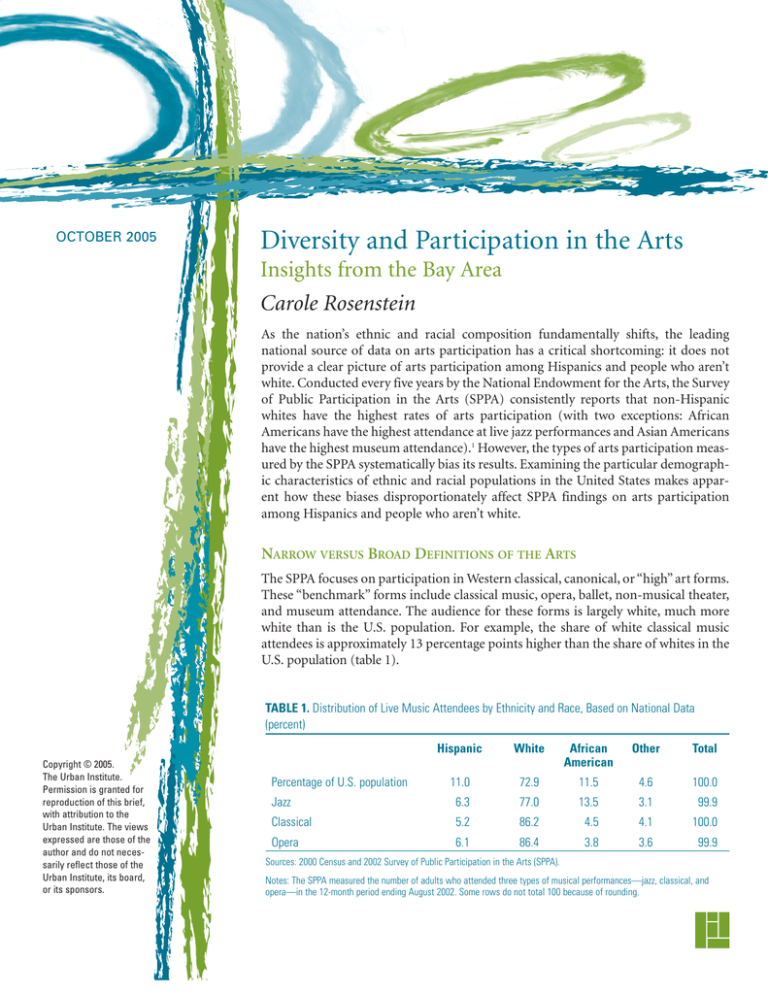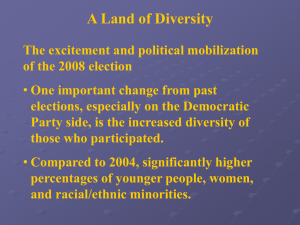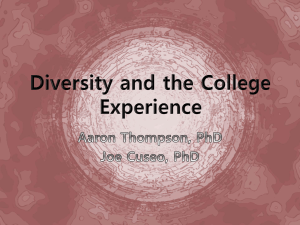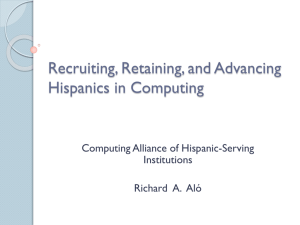Diversity and Participation in the Arts Insights from the Bay Area
advertisement

OCTOBER 2005 Diversity and Participation in the Arts Insights from the Bay Area Carole Rosenstein As the nation’s ethnic and racial composition fundamentally shifts, the leading national source of data on arts participation has a critical shortcoming: it does not provide a clear picture of arts participation among Hispanics and people who aren’t white. Conducted every five years by the National Endowment for the Arts, the Survey of Public Participation in the Arts (SPPA) consistently reports that non-Hispanic whites have the highest rates of arts participation (with two exceptions: African Americans have the highest attendance at live jazz performances and Asian Americans have the highest museum attendance).1 However, the types of arts participation measured by the SPPA systematically bias its results. Examining the particular demographic characteristics of ethnic and racial populations in the United States makes apparent how these biases disproportionately affect SPPA findings on arts participation among Hispanics and people who aren’t white. NARROW VERSUS BROAD DEFINITIONS OF THE ARTS The SPPA focuses on participation in Western classical, canonical, or “high” art forms. These “benchmark” forms include classical music, opera, ballet, non-musical theater, and museum attendance. The audience for these forms is largely white, much more white than is the U.S. population. For example, the share of white classical music attendees is approximately 13 percentage points higher than the share of whites in the U.S. population (table 1). TABLE 1. Distribution of Live Music Attendees by Ethnicity and Race, Based on National Data (percent) Copyright © 2005. The Urban Institute. Permission is granted for reproduction of this brief, with attribution to the Urban Institute. The views expressed are those of the author and do not necessarily reflect those of the Urban Institute, its board, or its sponsors. Hispanic White African American Other Total 11.0 72.9 11.5 4.6 100.0 Jazz 6.3 77.0 13.5 3.1 99.9 Classical 5.2 86.2 4.5 4.1 100.0 Opera 6.1 86.4 3.8 3.6 99.9 Percentage of U.S. population Sources: 2000 Census and 2002 Survey of Public Participation in the Arts (SPPA). Notes: The SPPA measured the number of adults who attended three types of musical performances—jazz, classical, and opera—in the 12-month period ending August 2002. Some rows do not total 100 because of rounding. a taste for these forms and knowledge of the manners associated with attendance appear cultivated behaviors (Bourdieu [1979] 1984; Bourdieu and Passeron [1970] 1977; DiMaggio and Mohr 1985). Because the SPPA focuses on these narrowly defined “high” art forms, its findings skew toward higher rates for whites and Asian Americans, groups with higher levels of educational attainment. However, results from the Urban Institute’s Community Partnerships for Cultural Participation Survey show when a broader range of arts activities is included, the distribution of arts attendees by race and ethnicity comes more closely into line with population demographics (table 2). Conducted in 1998, the CPCP household survey asked residents of three Santa Clara County, California, communities whether they had attended a jazz, blues, classical music, or opera performance in the previous 12 months (the “narrow” definition of music presented in the table). The CPCP survey also asked about attendance at other live music concerts, including rock/pop/country/rap/hip-hop, religious music, Latin/Spanish/salsa, and rhythm and blues (the “broad” definition of music). The results for questions that used a narrow definition are similar to SPPA results at the national level, with audiences appearing much more white than the national population. When all types of music are included, however, the ethnic and racial distribution of music attendees is virtually identical to that of the population. PASSIVE VERSUS PARTICIPATORY DEFINITIONS OF ARTS PARTICIPATION The SPPA’s primary measure of arts participation is audience attendance in traditional arts institutions. Historically, traditional arts institutions actively excluded people of color (DiMaggio and Useem 1978). Although many institutions have improved outreach to underrepresented groups, these institutions continue to cater largely to white audiences (DiMaggio and Ostrower 1990; Smithsonian 2001). A growing body of field-based research suggests many Hispanics and people who aren’t white engage in “participatory” arts practices, where creative activities are shared and set in nontraditional venues like community centers, homes, libraries, and schools.4 Although the SPPA asks about amateur arts activities and some other individual participation that takes place outside traditional arts institutions, its results do not reflect participation in communal or shared “participatory” arts practices. The shift in the ethnic and racial distribution of arts attendees that occurs when a broader definition of the arts is used can be largely explained by looking at differences of educational attainment, which varies widely among ethnic and racial groups. Education is the most powerful social predictor of arts participation as measured in the SPPA.2 SPPA rates for arts participation broadly follow levels of educational attainment among ethnic and racial groups: whites and Asian Americans have the highest rates by both measures, African Americans and Hispanics have the lowest.3 The effect of failing to measure participatory arts activity is compounded when populations contain large numbers of immigrants. A recent survey of Santa Clara County, California, residents conducted in English, Spanish, and Vietnamese shows immigrant Hispanics and Asians reported much lower levels of arts activity in more passive forms of participation, While greater educational attainment is associated with overall increased rates of arts participation, it is particularly important for the Western classical or “high” arts. A substantial body of research shows both TABLE 2. Distribution of Live Music Attendees by Ethnicity and Race, Based on Regional Data (percent) Hispanic White African American Other Total Percentage of Santa Clara County population 24 44 3a 29 100 Distribution based on narrow definition of music 15 54 4a 28 101 Distribution based on broad definition of music 21 49 3a 28 101 Sources: Census 2000 and Urban Institute Community Partnerships for Cultural Participation (CPCP) Survey, 1998. Notes: CPCP “narrow” includes jazz, blues, classical music, and opera performances. CPCP “broad” includes any kind of music. See text for details. Some rows do not total 100 because of rounding. a The sample size of African Americans for the CPCP household survey was very small. Although the three respondents surveyed adequately represent the proportion of African Americans who make up the population of Santa Clara County, the statistics reported here are not robust and should not be seen to reflect participation rates among African Americans in the Bay Area. 2 DIVERSITY AND P A RT I C I PAT I O N IN THE A RT S TABLE 3. Variation in Arts Participation among Asian Americans and Hispanics by Nativity (percent) ASIAN AMERICANS HISPANICS Natives Immigrants Natives Immigrants Attended a live performance 100 82 75 60 Attended a museum 100 60 52 35 Considers self an artist 38 24 42 44 Favorite arts activity with others is dance 33 52 52 43 Source: Cultural Initiatives Silicon Valley, Community Creativity Index, 2002. Note: Unweighted data. such as attending museums or live performances, than did their U.S.-born counterparts. However, immigrants reported relatively high levels of participation in such activities as shared dancing, singing, and instrument playing. As table 3 shows, the margin of difference between native-born and foreign-born Asian Americans and Hispanics are striking when attendance is compared to a more participatory arts activity, such as dancing with others. There is also a clear difference in attitudes about artistic or creative engagement, with foreign-born Hispanics much more likely to consider themselves artists than those born in the United States. Because so much of the Hispanic and AsianAmerican population is made up of immigrants, differences between the preferences of those who are native- and foreign-born have a substantial effect when arts participation measures do not take them into account. Racial and ethnic groups differ drastically in the number of immigrants who make up their populations. In 2000, over half the U.S. foreign-born population was from Latin America and 40 percent of Hispanics in the United States were foreign-born. Among Asians living in the United States, 69 percent were foreign-born (Malone et al. 2003). Only approximately 6 percent of whites, African Americans, and Native Americans were foreign-born in 2000.5 The SPPA’s focus on passive rather than participatory arts activities skews its findings away from Hispanics and Asian Americans, whose populations contain many immigrants. MEASURING DIVERSITY IN ARTS PARTICIPATION The Survey of Public Participation in the Arts furnishes public- and private-sector decisionmakers with information vital to determining the public’s level of engagement with the arts, specific areas that need polDIVERSITY AND icy intervention, and how well direct and indirect public investment in the arts serve the citizenry. In the picture drawn by the SPPA, the population of people engaged with the arts in the United States is overwhelmingly white, much more so than is the U.S. population. The relatively narrow and passive definitions of arts participation used in the survey disproportionately affect the results measured among Hispanics and people who aren’t white, systematically producing lower rates of arts participation among these groups. Underestimation of arts participation among Hispanics and people who aren’t white may be considerable. In the Bay Area’s San Francisco and Alameda counties, the proportion of arts and culture organizations that represent and serve predominantly nonwhites, ethnic groups, and immigrants is substantial. Ethnic arts and cultural heritage organizations make up over 23 percent of all San Francisco area arts and culture organizations.6 To understand arts participation in a population that is increasingly diverse, it is essential to refine measures for ethnic groups, racial minorities, and immigrants. In highly diverse regions like the Bay Area, it is a necessity. When broad and participatory arts practices are included in measures of arts participation, rates of arts participation increase for the whole population.7 But, more important, participation in arts and culture among diverse populations comes into focus. Equitable arts participation among ethnic groups, racial minorities, and immigrants can be fostered not only by measuring broad and participatory arts practices, but also by supporting these practices through policies that sustain arts education programs; support community-based cultural heritage and ethnic, folk, and traditional arts organizations; and promote free P A RT I C I PAT I O N IN THE A RT S 3 and abundant public space. Such policies can serve as valuable tools for decisionmakers who wish to cultivate diversity in the arts and to support ethnic groups, racial minorities, and immigrants. REFERENCES Bauman, Kurt, and Nikki Graf. 2003. “Educational Attainment: 2000.” Census 2000 Brief. Washington, DC: U.S. Government Printing Office. Bourdieu, Pierre. [1979] 1984. Distinction: A Social Critique of the Judgment of Taste. Trans. Richard Nice. Cambridge, MA: Harvard University Press. Bourdieu, Pierre, and Jean-Claude Passeron. [1970] 1977. Reproduction in Education, Society and Culture. Beverley Hills, CA: SAGE Publications. Bye, Carolyn. 2004. “Brave New World: Nurturing the Arts in New Immigrant and Refugee Communities.” Issues in Folk Arts and Traditional Culture Working Paper #2. Santa Fe, NM: The Fund for Folk Culture. DiMaggio, Paul, and John Mohr. 1985. “Cultural Capital, Educational Attainment, and Marital Selection.” American Journal of Sociology 90(6): 1231–61. DiMaggio, Paul, and Francie Ostrower. 1987. Race, Ethnicity, and Participation in the Arts. Washington, DC: Seven Locks Press. DiMaggio, Paul, and Michael Useem. 1978. “Cultural Democracy in a Period of Cultural Expansion: The Social Composition of Arts Audiences in the United States.” Social Problems 26(2): 179–97. Kochman, Thomas. 1981. Black and White Styles in Conflict. Chicago: University of Chicago Press. Tepper, Steven. 1998. “Making Sense of the Numbers: Estimating Arts Participation in America.” Working Paper #4. Princeton, NJ: Center for Arts and Cultural Policy Studies. Wali, Alaka, Rebecca Severson, and Mario Longoni. 2002. Informal Arts: Building Cohesion, Capacity and Other Cultural Benefits in Unexpected Places. Chicago: Center for Arts Policy, Columbia College Chicago. ABOUT THE AUTHOR Carole Rosenstein is a research associate in the Center on Nonprofits and Philanthropy at the Urban Institute. A cultural anthropologist, her research focuses on cultural policy, cultural democracy, public culture, and the social life of the arts. ACKNOWLEDGMENTS Funding for this research was provided by the Walter and Elise Haas Fund. Jen Auer and Tim Triplett contributed research support. Thanks to Frances Phillips, Chris Walker, Francie Ostrower, Heidi Rettig, Carlos Manjarrez, John Kreidler and Cultural Initiatives Silicon Valley, Brendan Rawson, and CPANDA, the Cultural Policy and the Arts National Data Archive at Princeton University. NOTES 1 See Nichols (2003). 2 See DiMaggio and Ostrower (1987). In 2000, 61.5 percent of Asian Americans, 35.6 percent of whites, 19.1 percent of African Americans, 17.9 percent of Native Hawaiian/Pacific Islanders, 15.4 percent of Native Americans, and 14.2 of Hispanics reported having earned a bachelor’s degree or higher (Bauman and Graf 2003). The rate for Hispanics includes Hispanics of any race. 3 Kumar, Divya. 2004. “New Americans, Lasting Art: A Call to Build.” The Subcontinental 2(2): 41–54. Malone, Nolan, Kaari Baluja, Joseph Costanzo, and Cynthia Davis. 2003. “The Foreign-Born Population: 2000.” Census 2000 Brief. Washington, DC: U.S. Government Printing Office. Moriarty, Pia. 2004. Immigrant Participatory Arts: An Insight into Community-building in Silicon Valley. San Jose, CA: Cultural Initiatives Silicon Valley. Nichols, Bonnie. 2003. “Demographic Characteristics of Arts Attendance, 2002.” Research Division Note #82. Washington, DC: National Endowment for the Arts. Smithsonian Institution. 2001. Increasing Museum Visitation by Underrepresented Audiences: An Exploratory Study of Art Museum Practices. Washington, DC: Smithsonian Institution, Office of Policy and Analysis. Stern, Mark, and Susan Seifert. 2002. “Cultural Participation and Distributive Justice.” Working Paper #16. Philadelphia: University of Pennsylvania, Social Impact of the Arts Project. In social science literature, the classic example of this type of practice is “playing the dozens” (see Kochman 1981). More contemporary examples include the widespread practice of communal karaoke singing in Vietnamese immigrant homes (Moriarty 2004) and dance performance in South Asian homes (Kumar 2004). See also Bye (2004); Stern and Seifert (2002); and Wali, Severson, and Longoni (2002). 4 5 The rate for Hispanics includes Hispanics of any race. 6 From the National Center for Charitable Statistics/Guidestar database. Numbers reflect Form 990 returns for the year 2002. 7 The SPPA consistently reports lower levels of participation than other arts participation surveys. See Tepper (1998).






